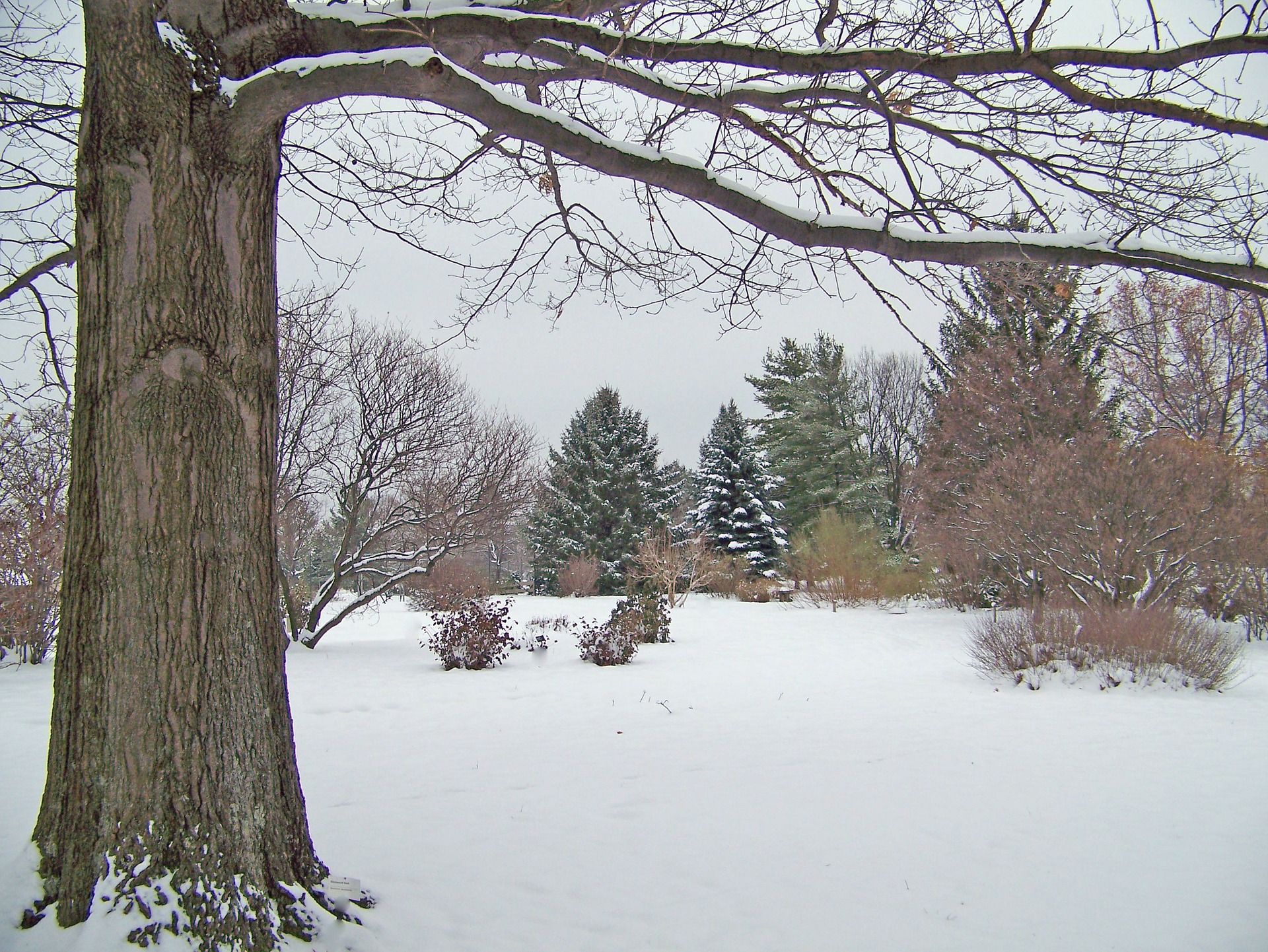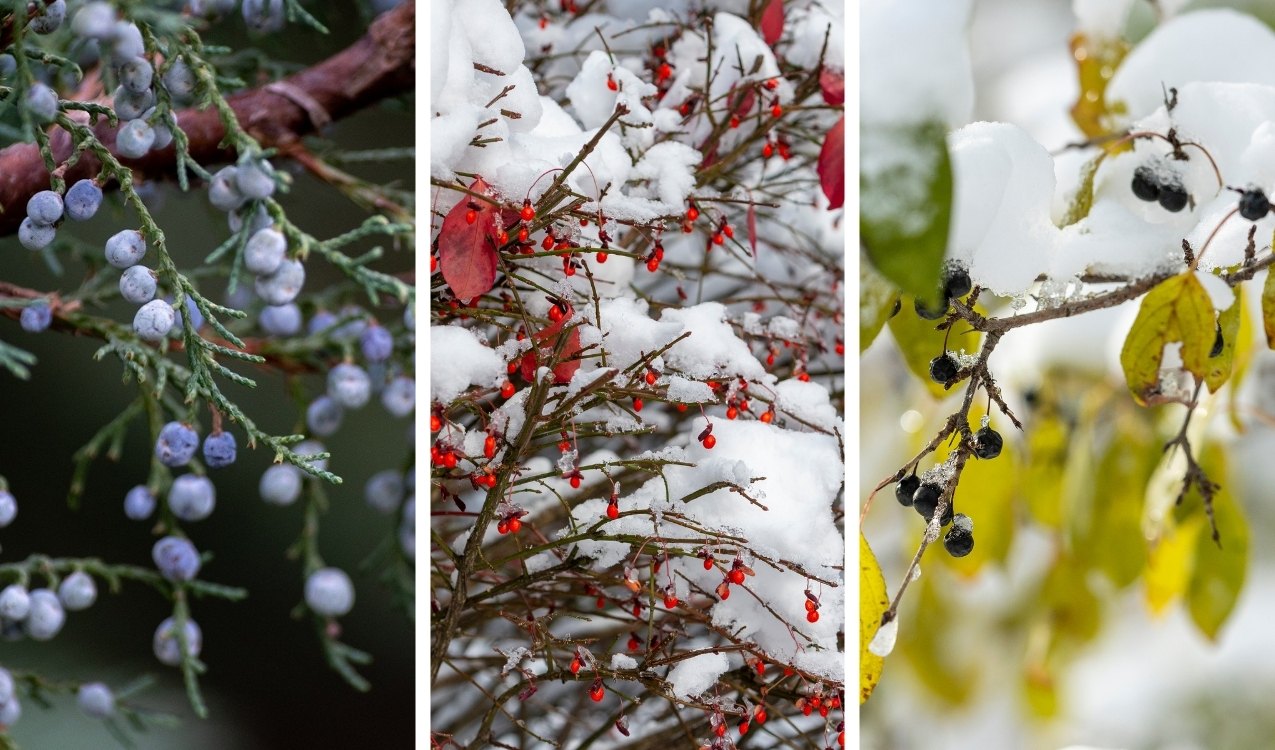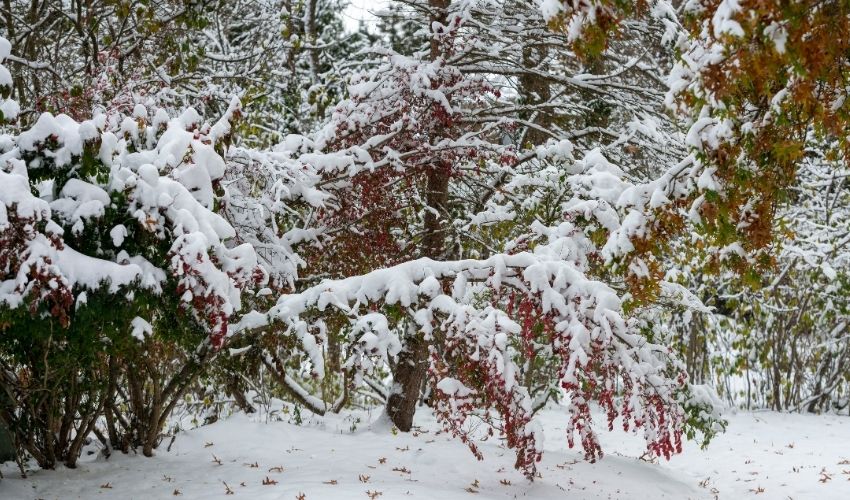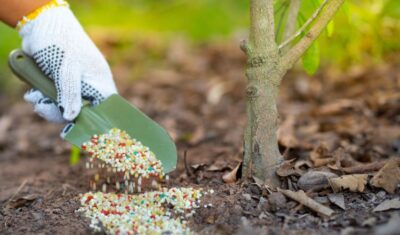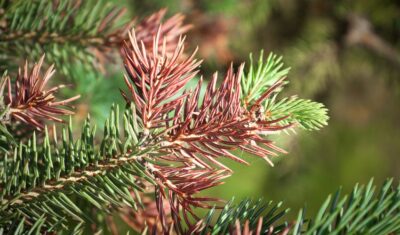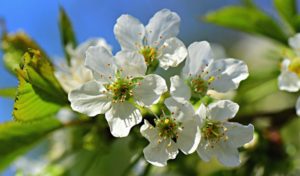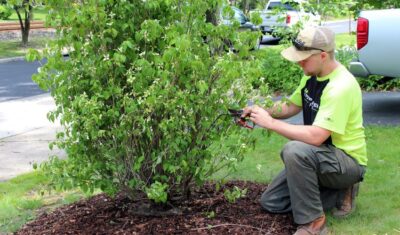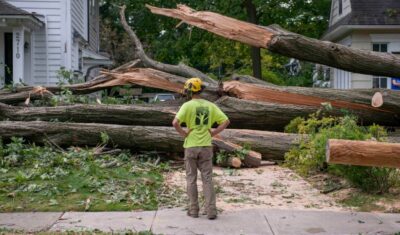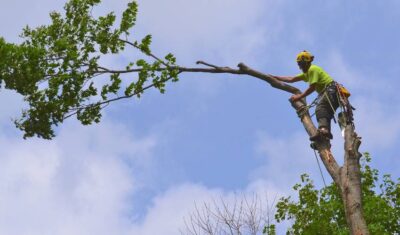During our long Northeast Ohio winters, it can seem like everything outside is hibernating. The trees have lost their leaves, the water is frozen over, and a blanket of snow covers everything.
That’s why it’s so helpful to remind ourselves of the things that are still alive, colorful, and vibrant during these gray winter months – like evergreen trees and shrubs, berries, and shrubs or trees with added color or texture. Not only do these trees and shrubs remind us that not everything is asleep all winter, but they have other benefits as well.
Most importantly, trees and shrubs can help create a wildlife-friendly landscape that helps reduce the negative effects of habitat loss on birds, bees, butterflies, and other wildlife species in Northeast Ohio.
In this article, we cover:
- plants to add winter color to your yard
- creating texture for winter interest
- the features of a wildlife-friendly landscape
- ways to create a landscape that looks good year-round and supports wildlife, especially during the winter
- plants to provide food and shelter
- benefits of evergreens
- recommended evergreen and deciduous native trees and shrubs for Northeast Ohio gardens.
We share our favorite ways to bring color and dimension to your yard, as well as tips to provide valuable food and shelter for wildlife. Colorful birds and active squirrels can make any property seem more alive during winter!
Add Some Color to Your Winter Landscape
Evergreen Foliage Colors
The color green is not only proven to produce a calming effect, but it is also shown to relieve eye strain. With so many shades of green available in nature, try to pick plants and trees that have different greens – from the dark green leaves on holly plants to the light bluish-green needles on blue spruce trees. Even choosing different kinds of evergreen trees can provide a range of green tones for your yard. (See our suggestions on which evergreen trees to plant below).
Attract Colorful Birds
Bird-watching experts will tell you that the trees not only provide a beautiful green backdrop during the snowy winter months, but they also attract different colors of birds. You might spot a blue jay or a robin, see the reddish white-winged crossbills searching for conifer cones, or notice the bright red of a cardinal brightening up your backyard.
Berries & Fruit
Some plants provide winter color through berries, such as bright red berries of holly and the blue of juniper. Certain types of holly, like winterberry, lose their leaves but leave bright, beautiful berries to bring a pop of color. As an added bonus, deer will generally steer clear of evergreen hollies.
While crabapple trees are popular for their spring flowers, certain varieties have fruit that will stay on the tree through January, providing not only a welcome shot of color but food for birds as well. Although they’re not native, they’re a valuable food source for many animals.
Late-Blooming Shrubs
Common witch-hazel blooms in October or November after the fall foliage has dropped. These yellow, spidery-looking flowers are sure to bring a unique look to your yard, especially as yellow is not a color often seen on plants in late fall and winter. Many types of birds prefer to nest on the branches of witch-hazel plants.
Colorful Stems
Certain types of dogwoods (Cornus Spp.) have striking red, yellow, or orange stems that stand out against the snow. To keep the vibrant color, we recommend that you prune the oldest branches back to the ground every spring; the new stems have the brightest color. You can see pictures of the varieties of shades available in this OSU Buckeye Yard & Garden Online blog post.
Texture Adds Visual Interest
Color may be the first thing you think of to add variety to your winter landscape, but the texture and varying shapes can increase the visual appeal of your yard as well.
American Sycamores, for instance, have striking gray or whitebark featuring green and brown “scales” that flake off during the summer, leaving the white wood underneath. This giant tree cannot be ignored in the winter, as its large size and wide canopy take over much of the space, and birds enjoy resting on its branches.
Similarly, paperbark birch lives up to its name; it has white bark that peels away like paper. Both of these trees will bring some texture and dimension to your yard during the winter months, even during those times when there is no snow.
A Wildlife-Friendly Yard Can Still Look Beautiful!
Beyond the trees and shrubs planted for color and texture, you can add life to your yard in winter by including plants that attract and protect wildlife.
A wildlife-friendly landscape is composed of these four essential items:
- food
- water
- cover or shelter
- a place to raise young
Native trees and shrubs will provide the most beneficial habitat for birds, bees, butterflies, mammals, and wildlife of all kinds, including those that overwinter in Northeast Ohio. These plants are adapted to local conditions and therefore require less maintenance (especially irrigation and fertilization). Native plants also provide the best quality food and shelter because the local wildlife species are adapted to use native plants. Planting native species also maintains the natural diversity of flora and fauna in the area.
Many people think of native plants as being ugly, weedy things. In some cases, they’re not something you’d want in your yard. But in many cases, including the trees and shrubs we recommend in this article (see below), native plants are beautiful.
Food for Wildlife
Several native Viburnums (Arrowwood and Blackhaw Viburnum) can be used as hedges. They not only add color and texture with their blossoms and leaves, they also develop fruit that’s a valuable source of food for wildlife and birds.
Some fall food sources can persist into winter, bringing a range of animals to your yard. Good choices include hawthorn, crabapple, sassafras, mountain ash, flowering dogwood, and beechnuts. And don’t forget the oaks for their acorns!
The berries on American holly are a good winter food source, as are buds on birch trees. Tulip trees and box elders retain their seeds into winter, attracting colorful birds like the Northern Cardinal and American Goldfinch.
Provide SHELTER FOR WILDLIFE
You may not see as much wildlife during the winter as you notice during the warmer summer months, but if you provide a healthy ecosystem for them, they’ll be there! Habitat trees, in particular, can support a wide range of animals throughout the winter. While a dead tree (also called a snag) provides the most benefits, living trees can also help wildlife survive the long, cold winter.
Habitat trees are “standing live or dead trees providing ecological niches (microhabitats) such as cavities, bark pockets, large dead branches, epiphytes, cracks, sap runs, or trunk rot” (Bütler, R., Lachat, T., Larrieu, L., & Paillet, Y., 2013).
For example, cavities in live trees can house birds, such as owls and woodpeckers, and small mammals, including bats. These cavities can be formed due to damage (such as a large branch breaking off and leaving exposed wood to rot) or excavated by cavity-nesting birds.
Naturally peeling bark, such as that found on shagbark hickory (Carya ovata) and paperbark maple, provides shelter for bats, insects, and amphibians (although they’re likely to be dormant in winter).
Grey squirrels are known to build their nests near the top of evergreen trees, birds of all types (the non-migrating kind) will find shelter and protection from predators amongst the branches, and you might even spot some deer prints in the snow (a good reason to make sure that you have deer protection in place for your trees!).
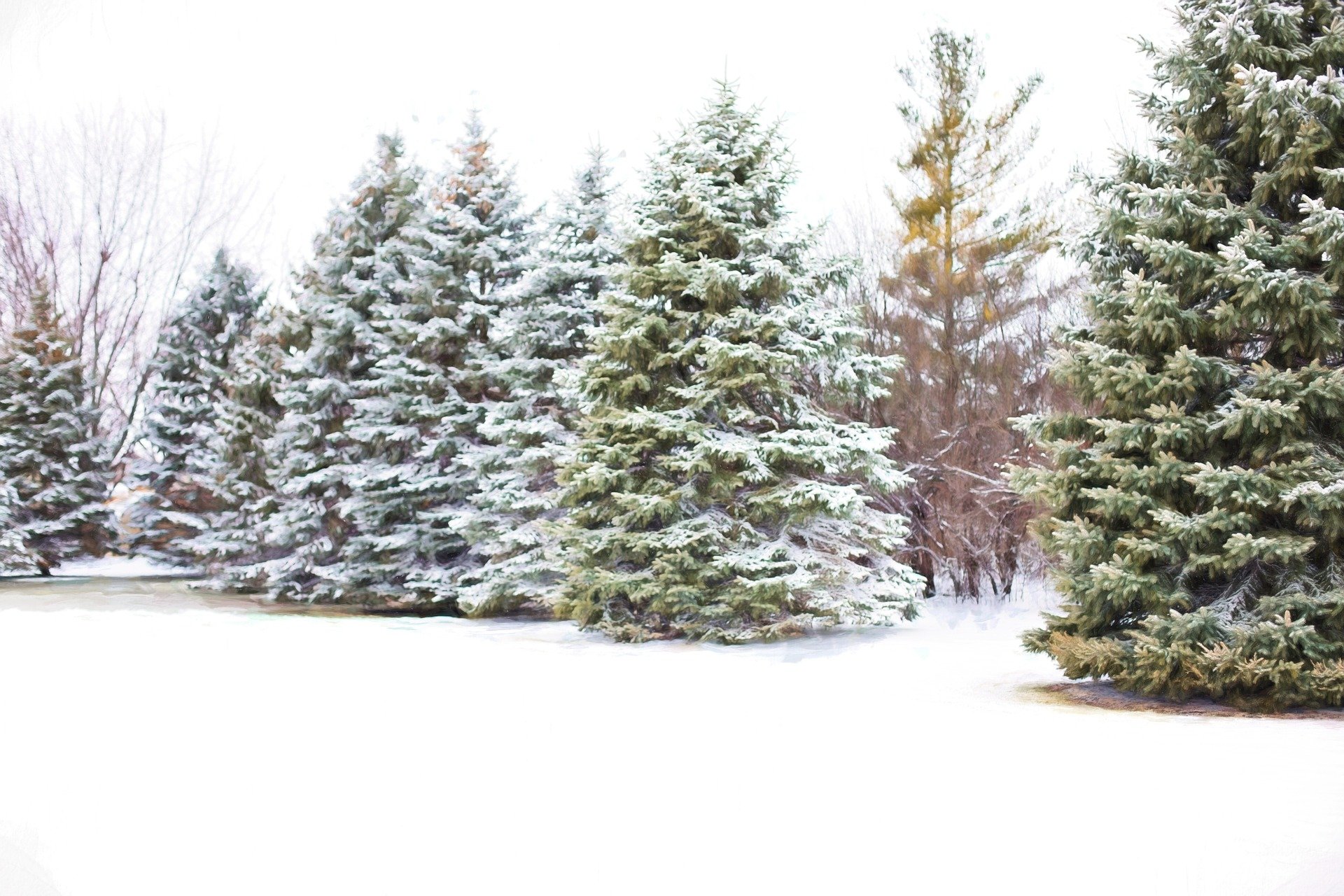
A row of evergreen trees, lightly dusted in snow, provides shelter from harsh winter winds
Evergreens Protect You, Too
Much like trees and their leaves provide shade and relief from the blazing summer sun, evergreen trees protect you (and your home) from harsh winter winds. They can also offer some sound proofing (up to 40%) and can act as an air pollution barrier, depending on the location and conditions. Because they keep their leaves or needles all year, evergreens also provide year-round privacy to your yard, and work as a natural fence.
Evergreens to Plant
Here in northeast Ohio, we have many evergreen shrubs and trees that can brighten the winter landscape, feed wildlife, and/or provide protection.
Common evergreen conifers include:
- hemlock (Tsuga),
- northern white-cedar or arborvitae (Thuja),
- spruce (Picea) and
- fir (Abies).
Native evergreens that support a wide range of birds and other wildlife include:
- Common Juniper (Juniperus communis)
- Eastern Red Cedar (Juniperus virginiana)
- White Pine (Pinus strobus)
- Canadian Yew (Taxus canadensis)
Some, such as yews and smaller junipers, are excellent foundation shrubs, while arborvitae can make a good privacy screen and Norway spruce can act as a good wind block. And don’t forget the many different types of holly (such as American holly and inkberry) for that extra pop of red or deep purple!
Native Deciduous Trees to Plant
There are many choices when it comes to native plants that can enhance your landscape. Below are the ones we recommend for winter interest and/or because they provide food or shelter for local wildlife during our cold winter months.
- Boxelder (Acer negundo)
- Black Maple (Acer nigrum)
- Red Maple (Acer rubrum)
- Silver Maple (Acer saccharinum)
- Ohio Buckeye (Aesculus glabra)
- Paw Paw (Asimina triloba)
- Shagbark Hickory (Carya ovata)
- Mockernut Hickory (Carya tomentosa)
- Hackberry (Celtis occidentalis)
- Red Bud (Cercis canadensis)
- Flowering Dogwood (Cornus florida)
- American Beech (Fagus grandifolia)
- Red or Green Ash (Fraxinus pennsylvanica)
- Honeylocust (Gleditsia triacanthos)
- Tuliptree (Liriodendron tulipifera)
- Sweetbay Magnolia (Magnolia virginiana)
- Red Mulberry (Morus rubra)
- Eastern Cottonwood (Populus deltoides)
- Black Cherry (Prunus serotina)
- Common Chokecherry (Prunus virginiana)
- White Oak (Quercus alba)
- Scarlet Oak (Quercus coccinea)
- Red Oak (Quercus rubra)
- Black Oak (Quercus velutina)
- American Basswood (Tilia americana)
Recommended Native Shrubs
- Black Chokecherry (Aronia melanocarpa)
- Cockspur Hawthorn (Crataegus crus-galli)
- Thicket Hawthorn (Crataegus punctata)
- Washington Hawthorn (Crataegus phaenopyrum)
- Dogwood (Cornus Spp.) [Red-osier (C. stolonifera), Silky (C. obliqua), Pagoda (C. alternifolia), and Gray (C. racemosa)]
- Running Strawberry Bush (Euonymus obovatus)
- Common Winterberry (Ilex verticillata)
- Spice Bush (Lindera benzoin)
- Common Ninebark (Physocarpus opulifolius)
- Smooth Sumac (Rhus glabra)
- Elderberry (Sambucus canadensis)
- Bladdernut (Staphylea trifolia)
- Maple-leaf Viburnum (Viburnum acerifolium)
- Arrowwood (Viburnum dentatum)
- Nannyberry (Viburnum lentago)
- Blackhaw Viburnum (Viburnum prunifolium)
Trees & Shrubs to Avoid
Introduced (exotic) species can become invasive, quickly outcompeting and killing our native plants. Some of the worst offenders here in northeast Ohio, and ones you should avoid planting, include:
- Multiflora Rose (Rosa multiflora)
- Privet (Ligustrum vulgare)
- Bush Honeysuckle (Lonicera maackii, Lonicera tatarica, Lonicera morrowii)
- Barberry (Berberis thunbergii)
- Russian Olive (Elaeagnus angustifolia)
- European Buckthorn (Rhamnus cathartica)
Avoid choosing horticultural varieties when possible; these altered varieties may not be appropriate for growing conditions in northeast Ohio nor provide the best resources for wildlife.
Read more about how to choose the right tree and planting location for your Northeast Ohio landscape.
Start Planning!
Winter is the perfect time to plan what landscape changes to make come spring. While many think of spring-flowering trees or beautiful fall foliage, we hope that this article has inspired you to also plan for a more varied winter landscape as well!
If you’d like specific winter tree suggestions for your yard, give us a call at 440-564-1374. We’ll even plant them for you!
We Can Help!
Schedule a property inspection with Independent Tree and let us know if you'd like suggestions on what to plant on your property. We can help you plan a more diverse landscape and even source and plant the trees for you. Contact us for more details.Recent Articles
Topics
About The Author

STAY IN THE LOOP
WITH OUR
LATEST UPDATES
"*" indicates required fields

